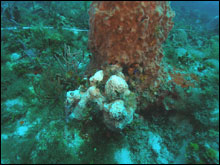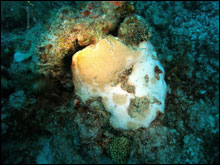Error processing SSI file
|
Coral Bleaching
Greg Piniak, Research Ecologist
NOAA Center for Coastal Fisheries and Habitat Research
 |
| Bleached Agaricia coral. (Photo: NOAA CCFHR) |
One thing we have seen fairly often during the cruise is coral bleaching. Corals are animals that contain symbiotic algae, called zooxanthellae. Corals derive a significant part of their energy from the zooxanthellae, which use light for photosynthesis and transfer the photosynthetic products (mostly carbohydrates) to the coral host. When conditions are stressful, the corals bleach -- that is, the zooxanthellae lose their photosynthetic pigments or are expelled from the coral. Bleaching is a general stress response that can occur in response to a variety of conditions, including high or low temperatures, low salinity, high or low light, or other factors. If the stress is minor or lasts only a short period of time, corals can often recover and sometimes may obtain a different type of zooxanthellae more suited to the new conditions. However, if the stress is too severe, the corals often die.
 |
| A portion of this bleached starlet coral (Siderastrea) retains some symbiotic algae, indicated by pale yellow areas. (Photo: NOAA CCFHR) |
The NOAA Coral Reef Watch produces a series of bleaching forecasts. Earlier this summer, conditions looked to be potentially very stressful for corals, and bleaching was considered very likely to occur. Though the forecast improved and conditions looked more benign, we have kept our eyes out for bleaching at both our permanent stations and our exploratory sites. We did see bleaching at virtually every site we visited in the Tortugas Ecological Reserve, Dry Tortugas National Park, and the unprotected areas. We saw bleaching across a wide range of depth-- from 110 ft up to 45 ft (we generally did not dive shallower than 45 ft). The starlet corals (genus Siderastrea) and the saucer/sheet/lettuce corals (genus Agaricia) were the most vulnerable to bleaching. The star corals (Montastrea faveolata and M. franksi) were also bleached at some sites. However, most of the Montastrea colonies and the brain corals (Colpophyllia and Diploria) were in good condition.
|



